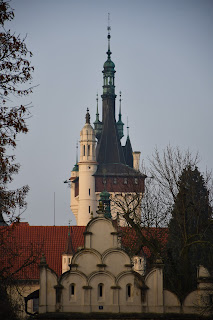Day 2 in Kilifi County: Passing through Gedi
Since I only work for half a day on Friday, I left my hotel-cum-office in Malindi not long after noon. I arranged with the hotel to find me a tuktuk driver who would take me to the town’s matatu stop, but once I climbed into the rickety three-wheeler and we started talking, he easily convinced me that it would be much faster to travel all the way to Gedi with him. His price was not exorbitant, and he very reasonably pointed out that if I took the matatu to Gedi, I would still have to either walk or take a tuktuk from the matatu stop to the site itself.
I found
Gedi besieged by school groups. Some of the children were quite fearless and
greeted all white people with loud “ciaos,” making the generally correct
assumption that most foreigners in the area were Italian. Foreigners seemed to
be of about equal interest to the children as monkeys, which they did not greet
but which still attracted little circles of onlookers. The foreigners were
braver. Encouraged by their guides, they showed the monkeys pieces of fruit,
prompting the monkeys to climb onto their shoulders and descend onto their arms
to the frantic tapping of fingers on mobile phone cameras.
Despite the
urging of the ticket salesman, I insisted that I did not want to go with a
guide when I found out it was not compulsory. I knew I wanted to take a lot of
pictures, and a guide would have slowed me down while telling me information
that I would have had to fact check when I got home. Instead, I wandered past
the incomplete visitor centre to the tiny museum, whose two rooms displayed
dishware and fragments of dishware from as far as Italy, Arabia, and China.
After spending one or two minutes there, I took a picture of the site map
outside the ticket control desk and walked in.
Gedi is
large but not difficult to navigate. The path from the ticket control desk
directly to the centre of the ruins, which has been almost completely cleared
of trees to reveal the full scale of the Great Mosque, the House of the Double
Court, the Palace, and several adjoining tombs. Still within the inner wall of
the city but overrun by trees stand the Large House, the Small Mosque, the
Mosque of the Sarcophagi, and the Mosque of the Three Aisles. Towards the outer
wall, the ruins become more derelict and there is not much to see beside trees
and beautiful purple butterflies.
Not all the
buildings that used to belong to old Gedi are contained within the main
complex. In fact, one big wall and several other structures belonging to an
erewhile mosque were discovered to the left of the ticket control desk, with
the wall held together by the roots of a tree. Behind this wall stands the
Snake Park of Gedi, a centre where snakes discovered around the complex are
brought instead of being killed. Housed in separate terraria, the snakes
include some of Africa’s most iconic reptiles, like the green and the black
mamba (which is actually grey but has menacing black gums), the puff adder, the
vine snake, the red cobra, and the only recently identified large brown
spitting cobra. A big African rock python also found a home at the centre after
fleeing a forest fire.



















Comments
Post a Comment